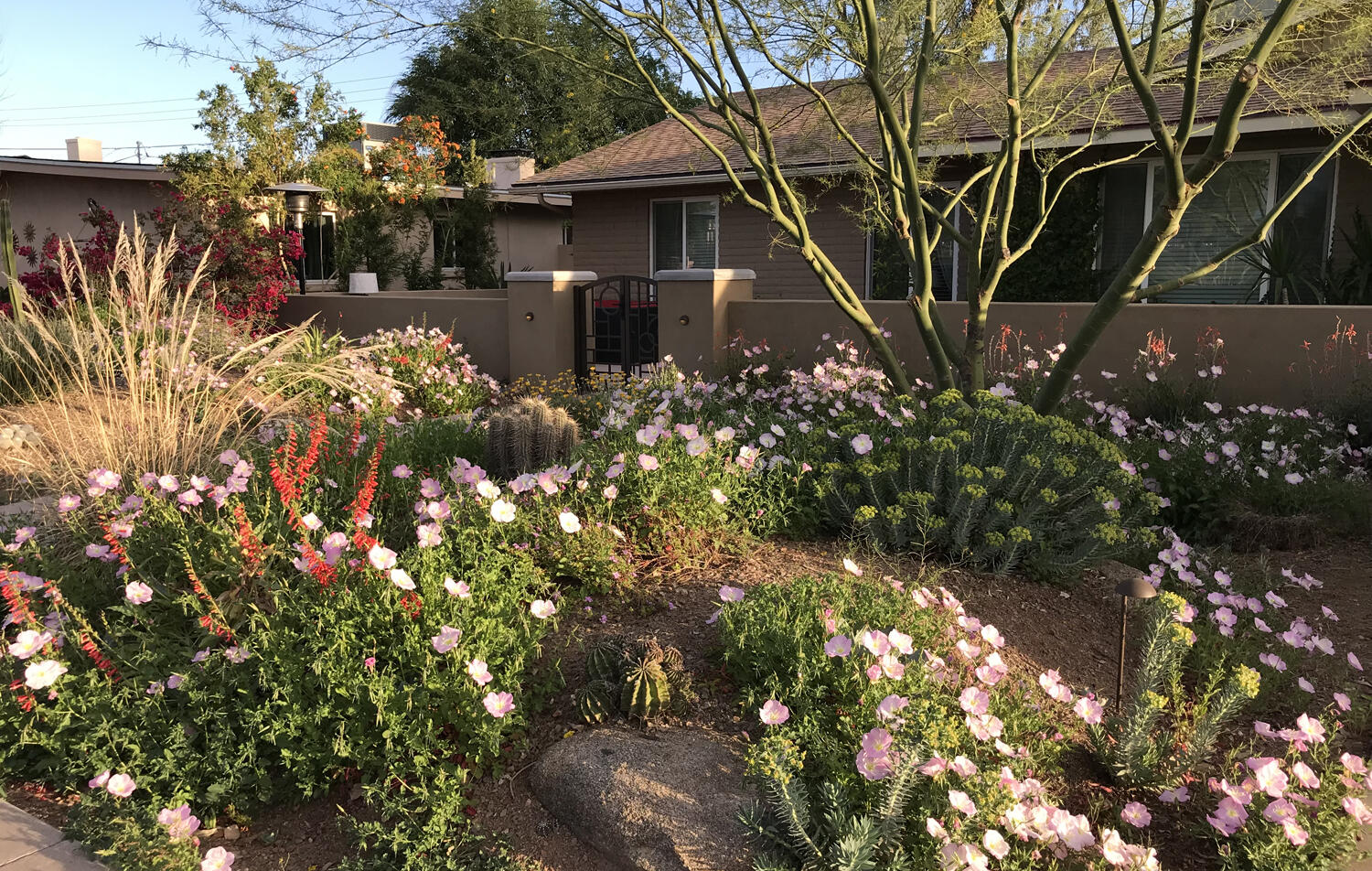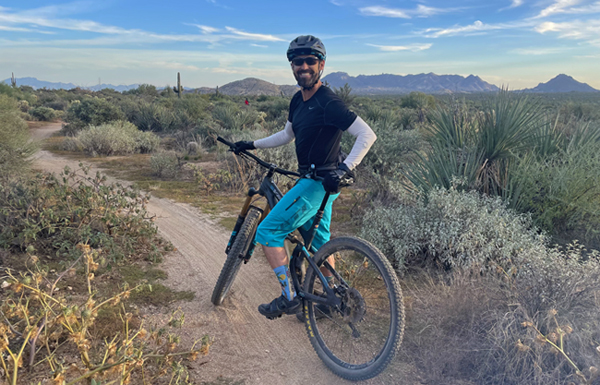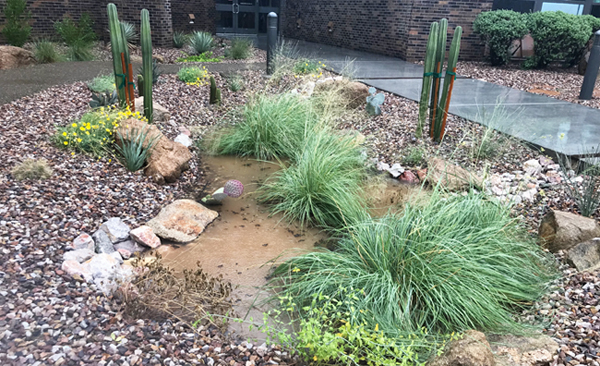
Innovating water conservation in Arizona
In the desert southwest, using water responsibly is critically important. As the new Director of Conservation Innovation with the Arizona Water Innovation Initiative (AWII) at Arizona State University, Harry Cooper is looking forward to continuing to innovate water conservation approaches.
Cooper is a landscape architect and champion for landscape water efficiency and conservation, and his unique perspective provides critical insights into Arizona's water future. His career path was influenced by a deep connection to the state's desert environment. Originally from the East Coast, he moved to Arizona in search of something different.
“Moving from the eastern US to the west, the Sonoran Desert really captivated me,” Cooper says. “There’s something magical about the desert—it’s unforgiving, and it teaches you a lot about resilience and adaptation. I'm a huge fan of desert plants, birds and getting outside.”

With degrees in landscape architecture and renewable natural resources management from the University of Arizona, Cooper has worked across public, private and academic sectors. For example, he spent more than 12 years with the Flood Control District of Maricopa County, where he focused on integrating water conservation and sustainable land management strategies into the planning, design and construction of large public projects.
Cooper was also influential in establishing the District’s Landscape Architecture and Water Conservation Branch and worked with both internal and external stakeholders to promote green infrastructure as an effective stormwater management and water conservation tool.
Cooper’s most recent position with the Arizona Municipal Water Users Association involved coordinating water conservation strategies with local municipalities. There, he facilitated the Landscape Technical Advisory Committee - in conjunction with the Arizona Department of Water Resources - on the review and update of the Phoenix Active Management Area plant list.
Cooper also provided his knowledge of desert ecology and landscape plants on the recent update of AMWUA's Landscape Plants for the Arizona Desert, a publication that showcases just over 200 low water drought tolerant plants that can be used on residential properties.
“It’s been a fascinating journey,” Cooper says. “As a landscape architect, I’ve had the chance to work on everything from small flood mitigation projects to large regional drainage studies, from advocating for drought-resistant and native plant materials in urban landscapes to stressing the importance of quantifying results of water conservation programs. Now, in my role at AWII, I’m focused on taking those experiences and developing innovative, collaborative water conservation solutions to address Arizona’s complex water challenges.”
A vision for water conservation in Arizona
Based on his decades of experiences, Cooper outlines a holistic approach for the future of water conservation in Arizona. He believes that water conservation should not be viewed as a separate, stand alone entity but as an integral part of Arizona’s overall water resources management toolbox.
“I see conservation and efficiency as more than just ‘using less water’. It needs to be deeply embedded in our state’s water solution mindset,” Cooper says. “Addressing our water security needs requires everyone to be on board and working together—from city planners and private developers to elected officials and individual homeowners."
"I recognize that conservation and efficiency alone are not going to solve all of our future water supply needs," Cooper continues, "but they can go a long way toward sustainable management of our limited resources and furthering the notion of a resilient and equitable future for our arid Southwest communities.”
A key focus for Cooper is enhancing water use efficiencies across both urban and rural environments. This involves addressing outdoor water use, which he considers a major area of opportunity.
“In most desert homes, a significant portion of potable water use goes toward outdoor landscaping - something like more than half and upwards of 70%,” Cooper explains. “We need to change the narrative around landscaping—moving from high-water-use lawns to desert-adapted landscapes—and continuing to improve irrigation efficiencies. This shift can have a significant impact.”
The challenges of implementing water conservation strategies
Despite the clear need for more comprehensive conservation measures, Cooper acknowledges several barriers. One of the most significant challenges, he explains, is the increasingly political nature of water issues.
“Water has become a highly politicized topic,” Cooper says, “and that’s something we need to navigate carefully.”
But even more challenging are the organizational silos and the lack of clear, quantifiable research on the impact of conservation strategies.
“We need to break down silos between different departments and organizations,” Cooper says. “Water issues affect everything—economy, environment, health. We need to approach it from a systems-thinking perspective. We need data that shows the real impact of conservation strategies, not just anecdotal evidence. That research will drive better decision-making.”
Another obstacle is outdated infrastructure, including water delivery systems that lose water.
“Losses from infrastructure may seem small percentage-wise, but when you look at the overall scale, it can be significant,” Cooper says. “Improving these systems and updating them with advanced technologies is crucial if we want to stretch our available resources.”
The role of green stormwater infrastructure and rainwater harvesting
A key strategy Cooper champions is the implementation of green stormwater infrastructure and rainwater harvesting. While these techniques are widely used in wetter parts of the country, they’re gaining traction in the arid Southwest.
“Green stormwater infrastructure and rainwater harvesting are underutilized resources here,” Cooper notes. “We need to capture as much water as we can when it does rain.”

The challenge, however, lies in the long-term effectiveness of these systems.
“Post-construction performance is something we need to address,” Cooper says. “It’s not just about putting in rainwater capture systems; we need to understand how much water we’re actually capturing and how much it offsets potable water use.”
In addition to saving water, these techniques also offer environmental benefits, including reducing urban heat islands and improving air quality.
“It’s about making our cities more livable, while also making the best use of the water we do have,” Cooper adds.
Looking ahead: Goals for the future
As Director of Conservation Innovation at AWII, Cooper is working to shape the future of water management in Arizona. His focus is to integrate water conservation and efficiency into all aspects of AWII’s work.
“My goal is to ensure that conservation is a cross-cutting theme across all areas of our work,” Cooper says. “I want to ensure that we make significant progress in addressing outdoor water use and expanding collaboration between different sectors and communities.”
Cooper remains optimistic about the future of Arizona’s water systems, even in the face of daunting challenges.
“Arizona has a history of being at the forefront of water management,” Cooper says. “From the Groundwater Management Act of 1980 to now, we’ve shown that we can rise to the occasion. I believe we can continue to make the right decisions, push forward innovative solutions, and build a sustainable future.”
Cooper’s vision for water conservation in Arizona is one of collaboration, innovation and sustainability. By integrating conservation into every aspect of water management, he aims to help Arizona thrive and is committed to ensuring that Arizona’s future is water-secure.
“Water conservation and supply augmentation is not an either/or issue—it’s a both/and,” Cooper says. “We need to find new sources of water and use the ones we have more wisely to ensure we’re on a path toward a more sustainable and resilient water future.”